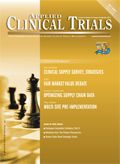A Shot in the Arm for European Clinical Trials?
Applied Clinical Trials
New phase of innovation initiative emphasizes focus on research networks, adaptive trials, and personalized medicine, among other key areas.
Some fresh impetus to modernizing European approaches to clinical trials may emerge from the launch last month of the new, improved Innovative Medicines Initiative (IMI)—the public-private partnership between the European Union and the pharmaceutical industry. IMI2 claims to be more than a second phase of the research-support program launched in 2008. It is not just that it will have more money (although at $4.5 billion, its funding for the next seven years is more than 50% higher). It is based on a new strategic research agenda, itself inspired by the 2013 update of the World Health Organization's report on Priority Medicines for Europe. And it places a new emphasis on the needs of patients and society, and on the potential of personalized medicine.

Practical proposals
In practical terms, IMI2 suggests ways that may help to overcome the problems that arise from different countries' different approaches to the conduct of clinical trials. "The acceptance of a new design in one country may not be supported by another, making the conduct of global trials challenging," it acknowledges. So IMI2 will aim to establish, train, and maintain European networks of a new breed of investigators in all EU countries. The networks should, the partnership envisions, have "ample expertise and experience in designing and executing clinical trials for diagnosing, preventing, and treating disease as required to support delivery of clinical trials that address the priority health areas underpinning IMI2." In addition to hospitals with disease management expertise, the networks will have to include individual experts in clinical trial design, regulators, the pricing and reimbursement agencies that take part in Europe's emerging health technology assessment framework, and experts in developing and delivering appropriate training.
These networks will also have to be able to command global recognition for their excellence, and be capable of effective collaboration with other national, European and global initiatives. Central tasks will include establishing best practice, standardized training materials, and feasibility assessment criteria. There will be a need for development of a standardized charter for clinical trial networks, including clear criteria for inclusion of sites, certification, quality control, and plans for sustainability, and these will need agreement from all key players across academia, industry, and regulators. Laboratory trial and research networks will also be required.
The results expected will include a "significant reduction in study set-up times," as well as lower costs. These improvements will be attained, says IMI2, through increased access to clinical sites trained in good clinical practice, and up-to-date reports on each site in terms of standards of care, diagnostics, patient flow, time process for institutional review, and contracting, as well as the availability of training materials for clinical investigators.
Explorations of theory
At a more theoretical level, IMI2 is to explore innovative adaptive designs more systematically. Noting the increased attention to probability inferences, it proposes closer scrutiny of the approach to avoid over-simplification. While "Bayesian statistical methods are being used increasingly in clinical research to minimize the number of patients included in a randomized clinical trial and decrease the chance of maintaining a patient in an unfavorable treatment arm," IMI2 says. Enumerating the potential benefits, the partnership counsels caution.
There is much in favor of these methods, IMI2 recognizes: "Accumulating results can be assessed at any time, including continually during the study, with the possibility of modifying the design of the trial; for example, by slowing (or stopping) or expanding accrual, unbalancing randomization to favor better performing therapies, dropping or adding treatment arms, and changing the trial population to focus on patient subsets that are responding better to the experimental therapies." But, IMI2 goes on, "While paved with good intent, many designs focus primarily on obtaining efficacy"—which presents challenges when balancing the need to collect sufficient data regarding potential adverse events. Trial design and analysis can become complex and bias can be introduced through changes of the patient population over time or changes in molecular strain characteristics. "More efforts are therefore required to refine the concept of adaptive trial design," IMI2 concludes.
Minimizing uncertainty
At the same time, even with these advances in clinical development, efforts aimed at minimizing regulatory authorities' uncertainties about safety and efficacy of new medicines and vaccines may still leave significant uncertainty over real-world effectiveness and risk, remarks IMI2. This can impede both the speed and level of patient access, the partnership warns. The lesson IMI2 draws from this is that with healthcare decision makers increasingly assessing a medicine in terms of expected future value in real-world clinical practice, with increased emphasis on value, or the relationship between outcomes and cost, "there is a need for better ways to measure outcomes (benefit and risk) that are clinically meaningful but standardized across countries and clinical setting." No easy task, IMI2 recognizes, dismissive of glib responses reliant merely on emerging e-health solutions.
It does not dispute the opportunity offered by the advent of digital media and the use of smartphones and tablets to develop new methods for collecting real-world benefit and risk data on the basis of more patient reported outcomes. But this presents its own challenges that still need answers—in particular in managing the collection, validation, and analysis of data, ensuring the cost-effectiveness of data collection, and complying with requirements of privacy laws and data security. A framework to address data privacy and personal integrity issues inherent in the use of health records and personal genomic data will be needed, IMI2 stresses.
Alongside the growing demand for demonstration of value, drug development itself is progressing further toward precision medicine approaches, IMI2 points out. This, it adds, is driving the need for development of new patient-focussed clinical outcome measures and new clinical trial paradigms that can support the evaluation of benefit and risk in small stratified patient populations. Equally necessary will be infrastructures for collection and sharing of trial data, together with methods for meta-analysis of trial data to investigate outcomes across multiple stratified trials in different locations.
Priority to patients
The increased attention to patients that is implicit in IMI2's focus on personalized medicine is reflected in more explicit fashion throughout the strategic agenda. "Patient input will be essential to the development of new outcome measures and integrated treatment paradigms that move away from a medicine-only approach to one of a personalized care package," IMI2 says. Each chapter of the research agenda ends with a summary—more or less credible—of the intended or supposed benefits to patients.
Core objectives include establishing "a framework with clearly defined rules, ethical standards, and data privacy measures to support the interaction of key stakeholders (especially patient groups) involved in the clinical development of new medicines and vaccines." IMI2 will aim to "develop innovative clinical endpoints which more closely reflect value to the patient," such as patient-reported outcome measures. It will seek greater "involvement in the healthcare ecosystem" of patient and citizen needs, and mechanisms to ensure patients and citizens are "suitably educated regarding the health options available to them, as well as a more open dialogue between patient and healthcare providers."
The program will also devote greater attention to patient adherence to prescribed dosing regimens—not just in patients with relatively minor illnesses, but also to those suffering from life- threatening conditions; it describes some of the figures of non-compliance as "staggering." This problem is set to become more prevalent as healthcare is increasingly pushed outside the hospital setting and the age of the population increases, IMI2 predicts. What it has in mind for effective adherence programs is an integrated approach with services, including clinical support and education to patients, the development of new drug delivery systems, and the development of robust, portable monitoring devices.
The strategic research agenda also speaks of encouragement for patient and disease advocate groups to become engaged in education on the science of clinical trials and translational research, and to become involved in sample collection, data sharing, collaborative study design, and analysis. Increased participation of citizens and patients early in the R&D process also offers the opportunity to better understand the needs of each individual, the behaviors that drive poor lifestyle choices and non-adherence to prescription regimes, and, therefore, offer the opportunity to create not just medicines, but integrated treatment programs tailored towards maximizing outcomes, says IMI2. Above all, to achieve the concept of precision medicine with its tailored treatment programs, "it will be essential to better understand individual patient behaviors, societal, lifestyle, and environmental factors that influence the engagement of patients with their treatment pathways, an area which to date has received little attention."
People getting sick in Europe may look forward to better treatments—but patients are also going to be doing a lot of hard work as this program rolls out.
Peter O'Donnell is a freelance journalist who specializes in European health affairs and is based in Brussels, Belgium.

Improving Relationships and Diversifying the Site Selection Process
April 17th 2025In this episode of the Applied Clinical Trials Podcast, Liz Beatty, co-founder and chief strategy officer, Inato, discusses a number of topics around site engagement including community-based sites, the role of technology in improving site/sponsor relationships, how increased operational costs are impacting the industry, and more.
Behind the Buzz: Why Clinical Research Leaders Flock to SCOPE Summit
February 7th 2025In this episode, we meet with Micah Lieberman, Executive Conference Director for SCOPE Summit (Summit for Clinical Ops Executives) at Cambridge Innovation Institute. We will dive deep into the critical role of collaboration within the clinical research ecosystem. How do we bring together diverse stakeholders—sponsors, CROs, clinical trial tech innovators, suppliers, patients, sites, advocacy organizations, investors, and non-profits—to share best practices in trial design, program planning, innovation, and clinical operations? We’ll explore why it’s vital for thought leaders to step beyond their own organizations and learn from others, exchanging ideas that drive advancements in clinical research. Additionally, we’ll discuss the pivotal role of scientific conferences like SCOPE Summit in fostering these essential connections and collaborations, helping shape the future of clinical trials. Join us as we uncover how collective wisdom and cross-industry partnerships are transforming the landscape of clinical research.